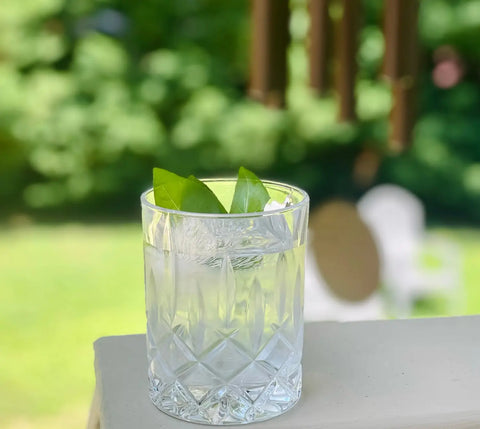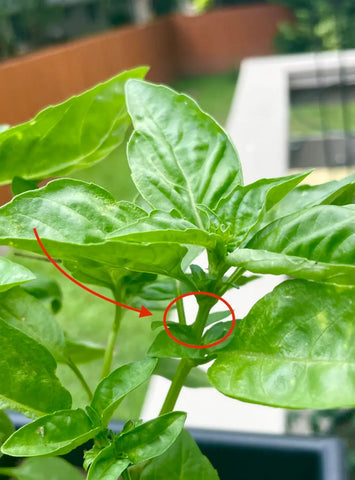A fragrant symbol of royalty, love, hate and…scorpions?
Ocimum Basilicum has been around for over 5,000 years. The world of basil is vast but nuanced, encompassing over 60 different varieties each with a unique flavor and visual profile. It is a culinary staple in Italian, Thai and Indian cuisines. Medicinally, its uses range from treating skin ailments to diabetes (just be sure to check with your doctor or holistic specialist first!) Truly, its most fascinating characteristic is its expansive spiritual history. This herb really runs the gamut of the devotional world.
First, the herb in your kitchen

Though a few sprigs of basil may not be enough to supplement your daily nutritional needs, it is a zesty and dynamic addition to any dish; rich in vitamins A, C, and K, flavonoids and lots of antioxidants. It’s delicious fresh, dried, chopped, or crisped but did you know you can slap it? Slapping a leaf between your palms releases the aromatics.
Ever seen a bartender smack your fancy cocktail garnish? Now you know it wasn’t personal.
It is a tender annual which means it does best in long growing seasons or in containers you can keep indoors. Pruning your basil plant regularly encourages high production of its peppery leaves. But don’t fret if your plant does go to flower; those are edible too! Plus, your pollinators will thank you.
Basil leaves are sometimes used to soothe skin afflictions; like the sting of a bug bite. The herbs oils have both anti-inflammatory and antibacterial properties that are most potent when first picked.
A few pruning tips:
-
Trim from the top. The biggest leaves may seem tempting but they are big for a reason - they absorb the most sunlight, collecting and converting high amounts of nutrients for the entire plant.
-
For every leaf you prune, you allow room for 2 more to grow in its place. Look for the tiny sets of leaves below your top leaves. Cut right above these baby buds and soon, new branches will emerge.
-
Fertilize! Basil is vigorous - replenish your soil often and you’ll grow a healthy, productive plant.

Once harvested, there are a few ways to prolong the life of your basil leaves. Store them like you would cut flowers - stems in a glass of clean water. If you clipped without stems, place your leaves on a dish cloth or paper towel, gently roll them up and store them in a plastic bag. Both methods do best if placed in the refrigerator.
Basil can be added to so many dishes! Just be sure to only add in the last minute of cooking; it'll lose it's flavor quickly once exposed to heat.
If you're looking for something more than a margarita pizza, try crisping your basil:
- Preheat the oven to 350 degrees.
- Place clean basil leaves in a single layer over parchment paper and a sheet pan.
- Drizzle very lightly with olive oil and salt and pepper.
- Bake for 3-5 minutes but keep an eye on them! The smaller leaves will crisp faster.
Basil beyond the backyard:
A Godly herb, basil is closely associated with spiritual worship across many different cultures. It’s been regarded as a symbol of chastity, a safeguard in the passage of life, a declaration of love, a protection from evil, a token to ward off the devil and it often grows in the presence of either great heroism or great hate. It all depends on who’s asking.
Tulsi basil is the Holy basil of Hinduism. Though related to Ocimum Basilicum, Tulsi Basil has a few notable differences: the stem is hairy and the leaves have ridged edges unlike the smoothness you find in sweet basil. Tulsi was named in honor of the Goddess Tulasi and it is often found growing in places of worship; prominently displayed and carefully kept.
Medieval legend says basil grew wherever the blood of Jesus had fallen. Egyptians relied on basil for embalming purposes. In India, it was buried with the dead to ensure safe passage from one realm to the next. The Portuguese gifted basil to those they loved the most and the rumor is, if your suitor showed up on your doorstep without it, well, he may not be as devoted as you had hoped.
The Ancient Greeks had a slightly different take: they believed basil only flourished in hate - cussing while planting to make sure the herb felt appropriately abused. So don’t worry if gardening sometimes makes you swear, you're simply helping your basil plant thrive!
About those arthropods…
Scorpions and basil have been linked several times throughout history. African legends say the plant keeps those scary insects away but there were others who believed placing a basil leaf between stones would conjure a scorpion in two days' time. No thank you!
For much of Europe, more basil meant more scorpions! Enter Nicholas Culpepper - an herbalist for the masses, Culpepper spent years translating Latin to catalog medicinal herbs and their origins.

He declared smelling too much basil could ‘turn your brain into a breeding ground for scorpions of the mind’ and many believed basil could birth the bug directly as a result. He viewed it as a poison due to its ability to draw the venom out of wounds.
For the herbalist, the logic was simple: ‘like draws like’ and keeping in tune with its associations of impurity, it was basil itself that encouraged evil (or venom) to come out.
The etymology of the word basil is a bit mixed as well: with both royal and viperous connotations. The Greek root basileus means ‘King’ but basil was often seen as the poor mans herb in Ancient Greece. Basilisk, of Greek mythology, was a small, venomous serpent with a crown shaped mark upon its head - similar to a scorpion wouldn't you say?
Whatever its true origins, we’re grateful basil has triumphed on its path to redemption and is now an everyday household herb. It’s rich in flavor and meaning, tender yet robust, easy to grow, simple to care for and quite tasty to boot. Keep a swear jar near by and it could be profitable too!
Something we do know for sure? If basil can conjure scorpions, swearing will soon follow. 🦂
Sources: Basil - An Herb Society of America Guide, History of Basil - The Spruce Eats, Etymology of Basil - Bon Appetit, Nicholas Culpepper - Kew: The Royal Botanical Gardens


You can propagate basil with cuttings. Just cut a few stems and put them in water like a cut flower. In a week or two, the stems will sprout roots. Let them grow a bit and plant them in soil.
For keeping basil on hand for soups, I just make a big batch of pesto, portion it into silicone ice cube trays and freeze. Once frozen, pop out the pesto cubes and store in the freezer in a vacuum sealed bag or ziplock bag. When you make soup, and don’t have fresh basil, pop a couple of those pesto cubes into the soup instead.
Of course, you can also just thaw them a bit and use them on crackers, pizza, etc. as well.
You can’t grow enough basil. esp since you really can’t preserve it to its equivalent freshness state. Think most herbs are best fresh.
I am very excited about your herb seeds. Thank you K
Amazingly easy to grow from seed. To dry, pluck leaves, spread out on sheet pan, and place in the sun on a hot sunny day. Crumble into jar and store in fridge.
Dry your basil leaves in the sun; in a 350 degree oven it will lose its flavor.